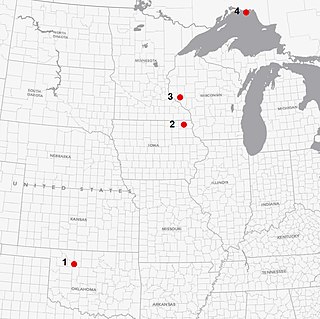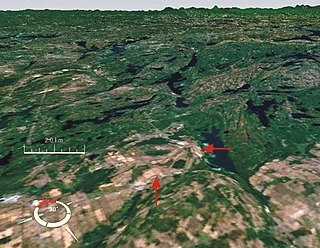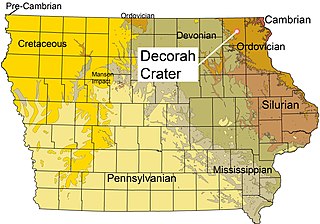
An impact crater is a depression in the surface of a planet, moon, or other solid body in the Solar System or elsewhere, formed by the hypervelocity impact of a smaller body. In contrast to volcanic craters, which result from explosion or internal collapse, impact craters typically have raised rims and floors that are lower in elevation than the surrounding terrain. Lunar impact craters range from microscopic craters on lunar rocks returned by the Apollo Program and small, simple, bowl-shaped depressions in the lunar regolith to large, complex, multi-ringed impact basins. Meteor Crater is a well-known example of a small impact crater on Earth.

A meteorite is a solid piece of debris from an object, such as a comet, asteroid, or meteoroid, that originates in outer space and survives its passage through the atmosphere to reach the surface of a planet or moon. When the original object enters the atmosphere, various factors such as friction, pressure, and chemical interactions with the atmospheric gases cause it to heat up and radiate energy. It then becomes a meteor and forms a fireball, also known as a shooting star; astronomers call the brightest examples "bolides". Once it settles on the larger body's surface, the meteor becomes a meteorite. Meteorites vary greatly in size. For geologists, a bolide is a meteorite large enough to create an impact crater.

Vesta is one of the largest objects in the asteroid belt, with a mean diameter of 525 kilometres (326 mi). It was discovered by the German astronomer Heinrich Wilhelm Matthias Olbers on 29 March 1807 and is named after Vesta, the virgin goddess of home and hearth from Roman mythology.

An impact event is a collision between astronomical objects causing measurable effects. Impact events have physical consequences and have been found to regularly occur in planetary systems, though the most frequent involve asteroids, comets or meteoroids and have minimal effect. When large objects impact terrestrial planets such as the Earth, there can be significant physical and biospheric consequences, though atmospheres mitigate many surface impacts through atmospheric entry. Impact craters and structures are dominant landforms on many of the Solar System's solid objects and present the strongest empirical evidence for their frequency and scale.

The Chicxulub crater is an impact crater buried underneath the Yucatán Peninsula in Mexico. Its center is offshore near the communities of Chicxulub Puerto and Chicxulub Pueblo, after which the crater is named. It was formed slightly over 66 million years ago when a large asteroid, about 10 kilometers in diameter, struck Earth. The crater is estimated to be 180 kilometers in diameter and 20 kilometers in depth. It is the second largest confirmed impact structure on Earth, and the only one whose peak ring is intact and directly accessible for scientific research.

Ames crater is a meteorite crater (astrobleme) in Major County, Oklahoma, United States. Ames, Oklahoma is near the center of the structure, which is 30 miles (48 km) southwest of Enid, Oklahoma. Buried under a thick layer of sediment, it was not discovered until 1991. Subsequent drilling within the crater found a large amount of oil and gas. It is one of the largest of six meteor craters associated with oil-producing formations in the United States.

The Holleford Crater is a meteorite crater near the community of Holleford, part of South Frontenac, Ontario, Canada. It is 2.35 kilometres (1.5 mi) in diameter and the age is estimated to be 550 ± 100 million years. Although there is a surface depression over the area, the crater itself is not exposed at the surface.
Tookoonooka is a large meteorite impact crater (astrobleme) situated in South West Queensland, Australia. It lies deeply buried within Mesozoic sedimentary rocks of the Eromanga Basin and is not visible at the surface.

Woodleigh is a large meteorite impact crater (astrobleme) in Western Australia, centred on Woodleigh Station east of Shark Bay, Gascoyne region. A team of four scientists at the Geological Survey of Western Australia and the Australian National University, led by Arthur J. Mory, announced the discovery in the 15 April 2000 issue of Earth and Planetary Science Letters.

Iturralde Crater is an 8-kilometre (5.0 mi) diameter circular geophysical feature in Madidi National Park in the Bolivian portion of the Amazon Rainforest, first identified from Landsat satellite imagery in 1985. The structure is located in a remote area in the Abel Iturralde Province of La Paz Department and was visited by researchers in 2002. Based on the presence of millions of glass beads, it has been hypothesised that the structure was created in the Late Pleistocene by the air burst of a non-impacting meteorite, similar to the Tunguska event in 1908.

The geology of solar terrestrial planets mainly deals with the geological aspects of the four terrestrial planets of the Solar System – Mercury, Venus, Earth, and Mars – and one terrestrial dwarf planet: Ceres. Earth is the only terrestrial planet known to have an active hydrosphere.
Bow City is a former village located in southeast Alberta, Canada. It is located on Highway 539 on the south shore of the Bow River approximately 31 km (19 mi) southwest of the City of Brooks. The Hamlet of Bow City is located 3.5 km (2.2 mi) to the east on the north side of the Bow River in the County of Newell.

The Eltanin impact is thought to be an asteroid impact in the eastern part of the South Pacific Ocean that occurred around the Pliocene-Pleistocene boundary approximately 2.51 ± 0.07 million years ago. The location was at the edge of the Bellingshausen Sea 1,500 km (950 mi) southwest of Chile, with a seafloor depth of approximately 4–5 kilometres (2.5–3.1 mi). The asteroid was estimated to be about one to four km in diameter. No crater associated with the impact has been discovered. The impact likely evaporated 150 km3 (36 cu mi) of water, generating large tsunami waves hundreds of metres high.

The Decorah crater, also called the Decorah impact structure, is a possible impact crater located on the east side of the city of Decorah in Iowa, United States. It is thought to have been caused by a meteor about 200 metres (660 ft) wide which struck during the Middle Ordovician Period, circa 470 million years ago.
The Corossol structure, which is also known as the Corossol crater, is a circular, 4.3-by-3.9-kilometre in diameter, underwater bedrock feature that is exposed on the gulf floor of the northwestern Gulf of Saint Lawrence 20-kilometre (12 mi) offshore of the city of Sept-Îles, Quebec in eastern Canada. It is hypothesized to be a possible pre-Pleistocene, extraterrestrial impact structure. It lies underwater at a depth of 40–208-metre (131–682 ft). This underwater feature was found during the study of high-resolution bathymetric and sub-bottom profiler data collected south of the city of Sept-Iles in the northwestern Gulf of Saint Lawrence.
Bloody Creek crater, which is also known as the Bloody Creek structure, is a 420-by-350-meter in diameter elliptical feature that is located in southwestern Nova Scotia, Canada. It is argued to be either a possible extraterrestrial impact crater or an impact structure. It lies between Bridgetown and West Dalhousie, Annapolis County, Nova Scotia, where the Bloody Creek structure straddles what was once a stretch of Bloody Creek. It also is informally known as the Astrid crater.
Praia Grande crater is a 20 kilometres (12 mi) diameter circular feature in the Santos Basin offshore Brazil. It is a possible impact crater that has been identified on 3D seismic by Petrobras in 2004. Further investigation is needed to obtain more information on the structure. The Russian Academy of Sciences lists the structure as a probable impact crater.

Hiawatha Glacier is a glacier in northwest Greenland, near Inglefield Land. It was mapped in 1922 by Lauge Koch, who noted that the glacier tongue extended into Lake Alida. Hiawatha Glacier attracted attention in 2018 because of the discovery of a crater beneath the surface of the ice sheet in the area. A publication noted in 1952 that Hiawatha Glacier had been retreating since 1920.
















